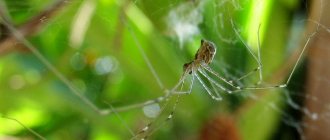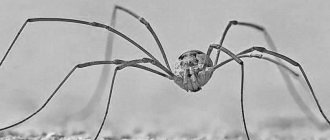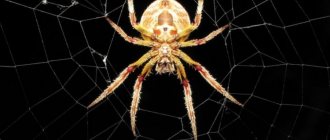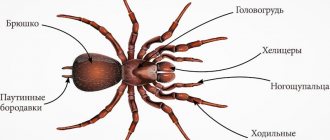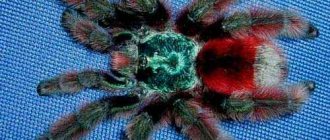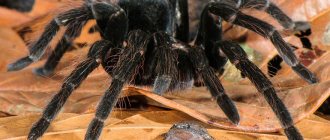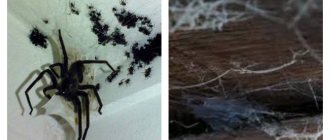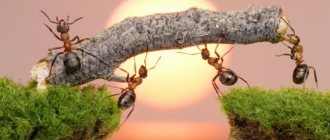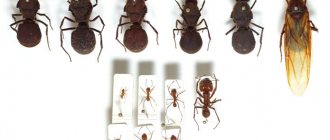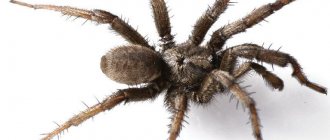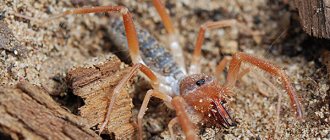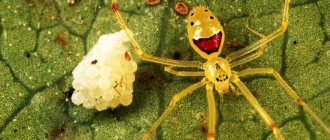Is the funny braid really poisonous? It has always been believed that these touching graceful creatures do not pose a danger to humans.
A harmless, long-legged insect running around the house evokes affection. No one has ever thought of killing them (some people believe that if a spider is killed, it can even lead to misfortune).
The bizarre creatures are not considered dangerous, but according to some reports, harvestmen have a powerful poison. And the only thing that stops them from killing us with a deadly “kiss” while we sleep is that their fangs are too short to pierce our skin. It seems incredible! But is this really so?
First, let's figure it out - how much do we know about these creatures? And are they actually spiders?
Origin of the species and description
Photo: Harvesting spider
The evolution of arachnids is relatively poorly studied. It is known that they have inhabited our planet for hundreds of millions of years, and their ancient ancestors became the first sea creatures to reach land and adapt to life on it. Their most important evolutionary acquisition was the web.
Gradually, spiders found more and more uses for it, and other creatures even learned to fly to escape from them and their web. Now very ancient species of spiders cannot be found, since they are constantly changing, and new species are replacing old ones.
Video: Harvesting spider
Thus, the family of harvest spiders formed “only” 0.5-2 million years ago - by the standards of evolution, this is indeed a very short time period. How exactly the development of harvest spiders took place, and from whom they originated, has not yet been reliably established; their research continues.
The name of the family in Latin is Pholcidae. It was described by K.L. Koch in 1850. In total, it includes as many as 94 genera, and about 1,820 species - and new ones are still being discovered, because most of them live in the tropics, often in sparsely populated, remote regions of our planet.
In the last two years alone, B. Huber has described several dozen genera, including hundreds of species living in various parts of our planet: Arnapa in Indonesia and New Guinea, Muruta and Nipisa in Malaysia, Pemona in Venezuela, Magana in Oman - and so on. .
This shows how much work remains to be done by the scientific community regarding spiders in general, and the family of harvest spiders in particular: even the description of their species is far from complete, not to mention building a clear picture of evolution - the foundation on which further study must be built.
Classification
Systematics divides these creatures into four main suborders.
Cyphophthalmi
A small suborder containing about 220 genera. These are primitive harvesters, whose fossil remains are found by paleontologists in Carboniferous deposits.
Representatives of this suborder have an oval oblong body, no more than 2 mm long. The legs are short. They live in the tropics and subtropical regions of Africa, South America and Eurasia.
The suborder includes two large families - Sironidae and Stylocellidae.
Eupnoi
This suborder includes the pigtails with the longest limbs. They have large eyes, a soft belly and special vitality.
They easily tolerate cold, being active until the first frost. Due to their special frost resistance, they settled throughout the planet. They are found on mountain slopes, deciduous and coniferous forests.
The suborder has 1,800 species, united in two families - Phalangiidae and Caddidae.
Dyspnoi
The most ancient representative of this suborder, Ameticos scolos, was discovered in coal deposits in France. Now it includes 320 modern species.
Very motionless species that sometimes seem lifeless. They live in the southern regions of Russia, in the vast expanses of Europe and Southeast Asia.
The legs are short. There are species that have an elastic abdomen, but there are also armored coverings. The suborder includes four families - Ischyropsalidae, Nemastomatidae, Trogulidae, Dicranolasmatidae.
Laniatores
The most numerous tropical suborder. Includes more than 4 thousand species. It is also the most mysterious, as it is the least studied.
Representatives of the suborder have a brightly colored body with a very hard protective covering. The abdomen is characterized by small bumpy growths. The settlement area is extensive. Found in the tropics of Africa, South America, and Australia.
A large population lives in India. The largest suborder includes five families - Cosmetidae, Gonyleptidae, Triaenonychidae, Oncopodidae, Phalangodidae.
Appearance and features
Photo: Harvesting spider in nature
Depending on what species the harvest spider belongs to, its structural features can vary significantly. First of all, the differences concern its small body: in some species it is well divided into the cephalothorax and abdomen, in others the division is not so obvious, in some it is elongated, in others it is spherical - and so on.
Sizes can also vary greatly - you can usually find individuals with body sizes excluding legs from 2 to 12 mm. Moreover, although elongated legs are considered the main distinguishing feature of the family, their length in reality is also very different, and in some forest species they are no longer than the body.
But still, all such spiders living in the neighborhood of humans have very long legs - this is how they can be easily recognized. Among other common features, it is worth highlighting that there are four pairs of these legs, and the same number of eyes. However, cave-dwelling species have one fewer pair of eyes.
Males are inferior to females in the size of the body itself, but at the same time have longer legs. In addition, their pedipalps are also different, but this cannot be seen with the naked eye.
Interesting fact: Harvesting spiders are so named for their resemblance to ordinary harvest spiders - they are often confused. In fact, harvestmen are not spiders at all, and therefore do not spin webs. They also do not settle in houses; they can usually be seen in meadows and fields, as well as in bushes.
Now you know whether the harvest spider is poisonous or not. Let's see where he lives and what he eats.
Special Features
If you grab a haymaker's leg, it will easily come off. For a few more minutes, the severed limb will make convulsive movements.
The ease with which the limb comes off creates the misleading impression that the legs are loosely attached to the body. In fact, this is not true. The harvester deliberately separates the limb. The paw comes off like a lizard's tail. This autotomy helps the haymakers to escape from enemies.
The predator first stumbles upon the paws, and then is distracted by the moving limb while the animal flees. Therefore, you can often find individuals who have an incomplete number of legs.
Where does the haymaker spider live?
Photo: Poisonous harvest spider
Its habitat area includes almost the entire globe; they are absent only in the coldest places on earth - the Arctic and Antarctic. These spiders are also capable of living wherever humans live; they are found in Greenland and in the northernmost populated areas of Russia beyond the Arctic Circle.
But this applies to the inhabitants of residential buildings and apartments; in nature, they prefer to live in warm regions; winter frosts are difficult for them to endure. Therefore, in the wild there are a lot of them in the tropics and subtropics, and much less in temperate latitudes, and they are not found in cold areas.
Even in houses in the north they are less common - although still quite common. In nature, they like to settle in caves, other crevices and holes in trees or the ground, and old ruins of buildings. In inhabited houses and apartments, they prefer warmer places in the corners or behind radiators - in general they really like warmth and dryness.
Interesting fact: The harvest spider can move on its long legs, and quite dexterously, due to the fact that it combines mechanical and hydraulic principles. Bending of the legs occurs due to muscle contraction, but they extend for a completely different reason - due to the pumping of hemolymph.
This method of transportation saves a lot of energy. The work of the legs of the harvest spider is so interesting that science fiction writers come up with mechanisms with the same principle of operation, and scientists and designers strive to actually create such mechanisms - it is possible that they will appear.
Settlement area
It's time to find out where these amazing creatures live. Haymakers settled almost everywhere, occupying various natural landscapes.
The main species have chosen forests and meadows. They are found in mountain ranges, settling in rock crevices and caves. Some species have easily adapted to living conditions in cities, and therefore can be found in apartments, houses, and office premises.
What does the harvest spider eat?
Photo: Dangerous harvest spider
The basis of its menu is insects.
Among them:
- beetles;
- ants;
- flies;
- mites;
- midges;
- mosquitoes;
- aphid.
They very effectively exterminate living creatures that enter the apartment and prevent them from multiplying - this is why they are very useful. But there is also an obvious disadvantage of their presence in the house - the network. In harvest spiders they are very extensive and therefore very noticeable. One spider can entangle an entire corner, and then move on to the next one. Often their networks are located near the ceiling.
The net is not sticky, the whole hope is that the prey caught in it will become entangled, and this will give the spider time to attack it. He usually goes hunting after sunset. As soon as the victim is in the net, he approaches and further entangles her, using his long paws.
When she can neither dodge nor attack in response, the harvest spider bites her, injecting poison - it does not pose any danger to humans. When the victim dies, a digestive enzyme is injected into it, after which its tissue becomes a soft pulp, which it absorbs.
And the spider is also able to eat the remaining solid particles of the prey’s body: it tears them off with the help of chelicerae, and then crushes them with processes on the front legs and also eats them. If there is something left after the meal, he takes the food away and stores it for future use - after all, it doesn’t happen from day to day, sometimes no one gets caught in his net for a long time.
A hungry spider sometimes even begins to rush at prey that just happens to be close to the web, but is not entangled in it - in these cases, the hunt can be dangerous for itself, because sometimes the prey can be stronger and more dexterous than itself.
Often you have to go hungry in winter, because there are much fewer living creatures. Then the harvestmen begin to feed on other spiders, including fellow spiders or their eggs. Hunting for other spiders is carried out differently: the harvest spider tugs at their webs to lure them out, and then pounces. Of course, this is dangerous: the outcome of the fight may be different.
Interesting fact: If the prey is too large to be caught in the net, the harvest spider shakes the net so that it is clearly visible so that potential prey can avoid it. And even if she has already been caught, but still remains too dangerous, he can bite some of the threads himself so that she can escape.
First aid for bites
At the slightest suspicion of a poisonous spider bite, you should call an ambulance and provide first aid to the victim. First of all, it is necessary to wash off the remnants of the toxic substance, slow down the spread of the poison through the bloodstream, and relieve the symptoms of an allergic reaction. The choice of first aid depends on where the attack occurred. If you are at home, a home first aid kit will do; if you are outdoors, you will have to use improvised materials. So:
- Thoroughly rinse the bite from any remaining poison with running, mineral or spring water. Use laundry soap at home.
- Disinfect the wound with alcohol, ammonia, hydrogen peroxide, vodka or any alcohol infusion. Attention! Scratching the wound is strictly forbidden, as this can accelerate the spread of poison throughout the body.
- In case of a pronounced local reaction, apply any cold object, compress, ice cubes wrapped in gauze to the inflamed wound.
- To ease allergic manifestations, give the victim an antihistamine.
- If an arm or leg is injured, a tourniquet or tight bandage should be applied above the bite. This is necessary in order to slow down the blood flow and the spread of poison throughout the body.
- Give the victim more fluid so that the kidneys remove the poison from the body more quickly.
- In case of severe pain, give the victim an anesthetic.
Remember! If a predator bites you on the neck, face or mucous membrane, the slightest delay can cost the victim his life.
Reaction to a spider bite
A panicked attitude can accelerate the spread of toxic substances, which means it is important to remain calm. Then you need to carefully examine the site of the bite. If it turns slightly red, but there are no characteristic wounds or dots, the attack was carried out by a harmless spider (most likely, medical attention will not be required).
Features of character and lifestyle
Photo: Centipede spider
Many spiders from this family are synanthropes, that is, they accompany humans and are almost never found in the wild - they have adapted to live in houses and apartments, where they are much more comfortable and safe, because they are reliably protected from many predators.
They are active all year round - in winter they continue to weave webs as if nothing had happened, try to catch insects, although there are significantly fewer of them, sometimes they even lay eggs at this time of year. This is due to the fact that harvest spiders originally originated in the tropics, so the seasonality factor had no significance for them.
They spend their days in dark corners, hanging motionless in their web - hiding from the sun, since they do not like its rays even despite their love for warmth, and simply resting, gaining strength. The period of activity for them occurs in the dark. While people are sleeping, these spiders can actively move around the apartment in search of prey.
Although harvest spiders are capable of starving for a long time, their patience is not unlimited, and if there is no prey in the house for a long time, they simply leave it - usually this happens a month and a half after starvation, and go to more “grainful” places. Therefore, regular cleaning and removal of various types of midges will help him get rid of them.
Pathogenesis
The pathogenesis is based on the toxic effect of poisons - neurotoxic and necrotic (cytolytic), as well as the development of allergic and infectious reactions in response to a bite. Effects may be local only or with additional systemic reactions resulting from neurotoxicity.
The effect of spider venoms resembles strychnine , but is much weaker. After excitement, a loss of strength occurs and paralysis . The toxic complex biochemical mixture contains neurotoxic substances that paralyze the nervous system, as well as hemolytic substances that destroy the blood. Their main task is to kill and paralyze the victim, as well as protect and scare away the aggressor.
The mechanism of action of Latrotoxin, a component of most neurotoxic poisons
By its nature, it is a presynaptic neurotoxin, since the point of action of Latrotoxin is the presynaptic nerve ending. There, the dimeric toxin is able to contact protein receptors with a molecular weight of ~95,000, as a result of which the resulting complex induces the permeability of biomembranes and becomes a channel for calcium cations - triggering the release of neurotransmitters and accelerating this process by 1000-1500 times. When reserves are depleted, after 30-50 minutes a complete block of neuromuscular transmission occurs. This ultimately leads to overstimulation of the muscle motor neuron ganglia.
Social structure and reproduction
Photo: Harvesting spider
Spiders become sexually mature after about a year, during which they molt five times. After this, the males begin to produce a secretion for fertilization and look for a female. Having found its web, the male attracts attention: to do this, stepping on the web, he begins to shake.
When the female comes out, he feels her with his front legs, letting him know that he is ready to mate. Indeed, otherwise the female may try to attack him - do not forget that these spiders are no strangers to cannibalism. However, mating only postpones her attack: immediately after its completion, the male should flee.
If he becomes too weak during mating and cannot escape, the female will still eat him. Therefore, each mating is very dangerous for the male, and most often they fertilize no more than two or three females during their lives. But females live much longer, because no one tries to kill them after mating.
There are usually several dozen eggs, up to fifty. In this case, the female does not build a cocoon; instead, she simply pulls the eggs together with a net and carries them with her in the chelicerae. Because of this, some fall out - they do not develop further and die off.
A few weeks later, small spiders emerge from those eggs that remain in the cocoon. And here, too, not everyone is lucky - some spiderlings turn out to be weaker than others, and are not even able to break through the egg themselves and get out. The spider simply eats them. The rest develop quickly and soon molt for the first time.
During molting, they shed their cover - this is a very painful process, after which the spider's legs become short and its body is almost transparent. While the spiderlings grow up and experience molting, they continue to stay with their mother - she carries them with her in a net woven for this purpose.
Folk remedies for bites
What to do if a spider bite happens far from civilization, when you can’t get to the nearest populated area even in a couple of days?
To relieve unpleasant symptoms and speed up wound healing, you can use traditional medicine methods:
- Rinse the affected area with a solution - 1 teaspoon of vinegar per glass of water.
- Dilute baking soda with water to a paste and apply to the inflamed area.
- Wipe with lemon juice.
- Apply shaving foam for 5 minutes and rinse with cold water.
- Apply aloe leaves.
Attention! Any folk remedy, especially herbal ones, can provoke an allergic reaction and aggravate the condition of the victim. Therefore, it is better for allergy sufferers to refrain from such experiments.
After reading the presented review, many will wonder: is it possible to avoid a spider bite? To reduce the likelihood of an attack to a minimum, it is enough to follow some recommendations:
- Do not try to catch or hit the arthropod.
- Keep your home clean, not bypassing the most hidden corners.
- Once in nature, check your shoes and clothes, and keep your sleeping bags and tents closed.
- When going out of town, stock up on repellent sprays and creams.
- In the summer, close doors tightly and equip windows with mosquito nets.
In most cases, everything is limited to a local reaction, which goes away within a few days. Although no one is safe from meeting a dangerous individual. In order to promptly and competently respond to the consequences of a bite, it is important to equip your home first aid kit with everything you need, and when going into nature, take an “alarm suitcase” with you.
Natural enemies of harvest spiders
Photo: Centipede spider
In the wild, they have a lot of enemies, like other spiders.
A variety of predators are not averse to feasting on them, including:
- birds;
- mice and rats;
- proteins;
- toads;
- lizards;
- large insects;
- snakes.
The list is not exhausted by the above - almost any predator the size of a harvest spider to a squirrel would not mind catching and eating them. Larger ones are usually not so interested in food, however, they can be caught simply out of interest - for example, cats and dogs do this.
In houses and apartments, apart from pets, who usually have a moderate interest in spiders and eventually stop reacting to them completely, they have almost no enemies, and therefore their life is much easier than in nature. Their main enemies are other harvest spiders or large spiders of other species.
In addition to predators, they are threatened by parasitic fungi of the genus Cordyceps. They grow inside the infected spider until they fill it from the inside - naturally, it dies. After this, they break through and eat it completely, so that not even the chitinous shell remains.
Interesting fact: Although the web of these spiders is not sticky, some species still use glue. They have hairs on their pedipalps, which secrete glue during hunting. With its help, harvest spiders reliably capture the victim - it is enough to touch it once so that it no longer has a chance to escape.
Lifestyle
Most species are nocturnal predators. During the day they freeze in secluded places. Pets are hiding in the corners. Sometimes they can be seen frozen on the walls. A timid animal that immediately tries to hide when encountered.
Like all predators, they feed on animal food. The diet includes caterpillars, ants, mosquitoes, and various beetles. There are species that easily cope with snails. Some moss moths eat mushrooms, moss and other plant foods.
The structure of the oral apparatus allows it to absorb solid particles of prey. Food is crushed by pidipalps, which act as jaws.
Prevention measures
It is worth remembering that a spider bite is quite rare. During the warm period, there are only a few dozen such cases throughout the country. At the same time, about half a million people seek help every year if they are bitten by a tick. Therefore, you should not be afraid of an insect attack; it is enough to take a number of preventive measures.
The best way to avoid being bitten is to avoid the spider. These arthropods should not be handled so as not to provoke an attack. Regular cleaning and maintaining cleanliness will allow you to promptly get rid of insects that accidentally appear at home.
When going outdoors, you need to use special repellents that can repel spiders. Clothes must be closed. If you plan to spend the night in the forest, you should take with you a canopy or mosquito net, which will prevent insects from accidentally crawling inside.
What to do if you are bitten by a poisonous spider
